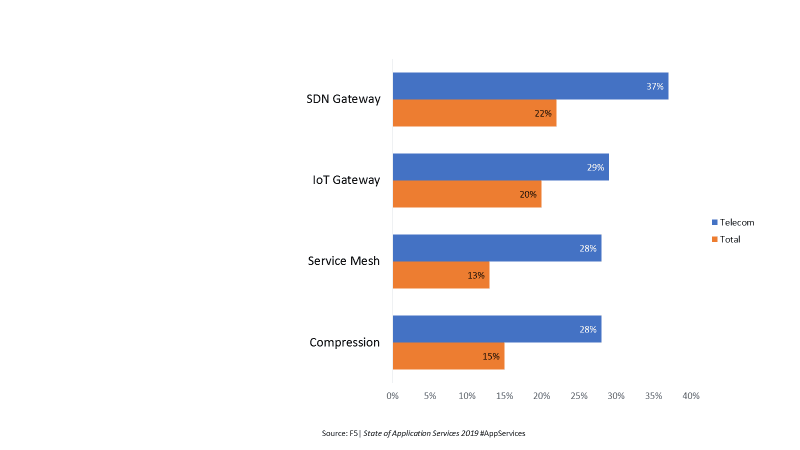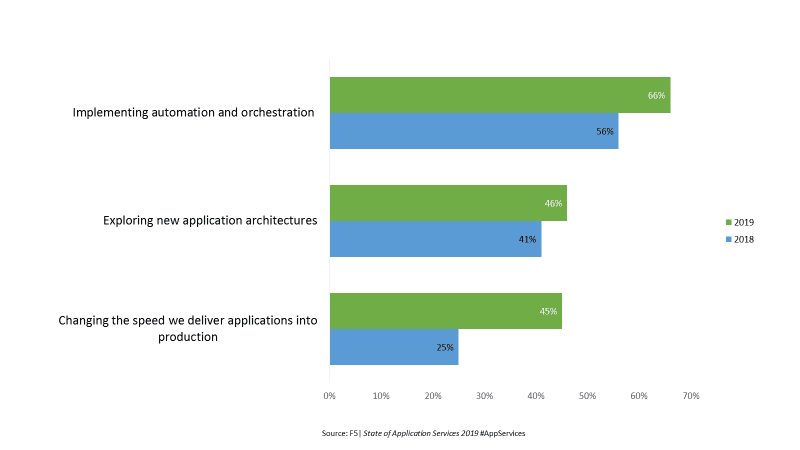The 2019 State of Application Services survey provides insights for how the telecom vertical is implementing application services in order to capitalize on the digital economy and transition to 5G. As the telecom network evolves to support a wide variety of use cases across different industry verticals, we note telecom respondents are raising their technology profile as leaders. Four out of five (80%) of telecom respondents are executing on digital transformation—well ahead of only 69% in the total global survey population. Telecom respondents are leading in not only technology investments but also re-evaluating their structures, processes, and workflows to reduce total cost of ownership as well as embrace more agile methodologies. Migrating away from single function (silo’d) IT teams is the first step, and we found that 58% of telecom respondents have embraced this change compared to 55% of the total survey population.
60% of respondents are employing containers, ushering in new deployments of application services.
Telecom respondents are slightly ahead of their peers with container adoption—three out of five (60%) compared to 56% of the total survey. Even more noteworthy is how telecom respondents distinguish themselves in how they are embracing newer application services. The top four application services planned for deployment in telecom are SDN gateway, IoT gateways, service mesh, and compression. The rise of containers has boosted the deployment plans for latter three, and compression speaks to the need to maintain a positive customer experience while reducing network costs. Looking at the top four for telco, you can see a stark contrast between those applications and the plans for the total population.

Application services enable telecom providers to meet the responsibilities they have to consumer, commercial, and government customers to deliver always-on network services with a keen understanding of applicable regulations as well as broader social environments. As a result, telecom providers are further ahead in the breadth of application services they deploy compared to their peers, with on average 17 application services deployed. Across all verticals, only 27% of respondents deployed more than 20 application services but, in the telecom vertical, 40% reported deploying over 20 application services.
71% of respondents are deploying automation and orchestration initiatives—and developer-oriented solutions are leading the charge.
Automation and orchestration will become essential to the efficient management of the network for telecom operators. Cloud-based microservice architectures are essential to the agile delivery of 5G but only with automation and orchestration can the operator keep up with the scale required while concurrently reducing operational costs. When we asked the respondents how digital transformation is influencing their application decisions, telecom respondents chose “implementing automation and orchestration” as the number one answer, with the percentage up from 56% in 2018 to 66% in 2019.

Additionally, telecom respondents are slightly ahead of the total survey population, reporting that 71% are employing automation and orchestration today compared to 68% in the total.
SDN and NFV enable telecoms to virtualize their network domains and respond to not only the enormous volume on their networks but the shift in traffic patterns from historically static point-to-point to the more dynamic and real-time requirements of IoT and cloud workloads. When uptime of the network was the primary requirement for telecom providers, it was a much simpler equation that didn’t necessarily require experimenting with new technologies. Their profile is changing though—particularly as it relates to 5G. In a world where network resources expand and contract based on network demand, profitable service will only be achieved with cloud-based microservices, automation, and orchestration—meaning the time is right to welcome telecom vendors as tomorrow’s technology leaders!
About the Author

Related Blog Posts

Nutanix and F5 expand successful partnership to Kubernetes
Nutanix and F5 have a shared vision of simplifying IT management. The two are joining forces for a Kubernetes service that is backed by F5 NGINX Plus.

AppViewX + F5: Automating and orchestrating app delivery
As an F5 ADSP Select partner, AppViewX works with F5 to deliver a centralized orchestration solution to manage app services across distributed environments.

Build a quantum-safe backbone for AI with F5 and NetApp
By deploying F5 and NetApp solutions, enterprises can meet the demands of AI workloads, while preparing for a quantum future.

F5 ADSP Partner Program streamlines adoption of F5 platform
The new F5 ADSP Partner Program creates a dynamic ecosystem that drives growth and success for our partners and customers.
F5 NGINX Gateway Fabric is a certified solution for Red Hat OpenShift
F5 collaborates with Red Hat to deliver a solution that combines the high-performance app delivery of F5 NGINX with Red Hat OpenShift’s enterprise Kubernetes capabilities.
Phishing Attacks Soar 220% During COVID-19 Peak as Cybercriminal Opportunism Intensifies
David Warburton, author of the F5 Labs 2020 Phishing and Fraud Report, describes how fraudsters are adapting to the pandemic and maps out the trends ahead in this video, with summary comments.
